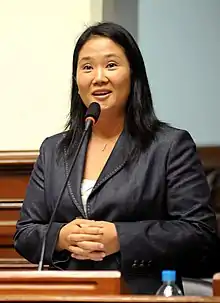Popular Force
Popular Force (Spanish: Fuerza Popular, FP),[9][10] until 2012 called Force 2011 (Spanish: Fuerza 2011),[11] is a far-right national-conservative Fujimorist[1] political party in Peru. The party is led by Keiko Fujimori, former congresswoman and daughter of former President Alberto Fujimori.
Popular Force Fuerza Popular | |
|---|---|
 | |
| President | Keiko Fujimori |
| Spokesperson | Carlos Tubino |
| Founder | Keiko Fujimori |
| Founded | 9 March 2010 |
| Headquarters | Lima |
| Ideology | Fujimorism[1] Conservatism[2] Anti-communism National conservatism Economic liberalism[3] Right-wing populism[4][5][6] |
| Political position | Right-wing[7] to far-right[8] |
| Colours | Orange |
| Seats in the Congress | 14 / 130
|
| Governorships | 0 / 25
|
| Regional Councillors | 4 / 274
|
| Province Mayorships | 3 / 196
|
| District Mayorships | 46 / 1,874
|
| Andean Parliament | 3 / 5
|
| Website | |
| www | |
Electoral history
2011 general elections
In the 2011 election, Popular Force supported the candidacy of Keiko Fujimori for President, Rafael Rey for First Vice President and Jaime Yoshiyama for Second Vice President.[12][13] Their ticket placed second with 23.55% of votes in the first round, but was defeated by Ollanta Humala's ticket in the runoff with 48.55%. The party obtained 37 seats in the Congress[14] and 1 seat in the Andean Parliament.
2016 general elections
In the 2016 elections, the party won an absolute majority in Congress (36.3% of votes; 71 out of 130 seats). In the presidential vote, party leader Keiko Fujimori was defeated again by a small margin, gaining 49.88% in the runoff against Pedro Pablo Kuczynski's 50.12%.
2018 local elections
In the 2018 elections, Popular Force saw a large loss of popularity with the party not being elected into a single position in Lima or in regional governments. Keiko Fujimori also saw an approval rating of 11% while 83% disapprove of her according to Datum.[15]
2020 snap parliamentary elections
In the 2020 snap parliamentary elections, Popular Force lost most of its seats in Congress from 73 to 15 seats after being the previous largest party in the 2016–19 Congress term.
Presidential election
| Year | Candidate | Coalition | Votes | Percentage | Outcome | |
|---|---|---|---|---|---|---|
| 2011 | Keiko Fujimori |  |
Force 2011 Alliance | 1st Round: 4 643 064 2nd Round: |
1st Round: 23.55 48.55 |
1st Round: 2nd 2nd Round: |
| 2016 | Keiko Fujimori |  |
Popular Force | 1st Round: 6 115 073 2nd Round: |
1st Round: 39.86 49.88 |
1st Round: 1st 2nd Round: |
Elections to the Congress of the Republic
| Year | Leader | Votes | % | Seats | Position | |
|---|---|---|---|---|---|---|
| 2011 | Keiko Fujimori | 2 948 781 | 23.0% | 37 / 130 |
Minority | |
| 2016 | 4 431 077 | 36.3% | 73 / 130 |
Majority | ||
| 2020 | 1 081 174 | 7.3% | 15 / 130 |
Minority |
References
- Vivanco, Martín Santiváñez (10 April 2011). "La triste procesión de las larvas grises". El Mundo.
- Manrique, Lisa (19 October 2010). "Transition in Lima: Leftist Candidate Victory". CSIS Center for Strategic and International Studies. Archived from the original on 21 February 2011. Retrieved 5 June 2011.
- http://www.celag.org/elecciones-en-peru-entre-el-neoliberalismo-conservador-y-el-neoliberalismo-design-por-barbara-ester/
- Salcedo, José Víctor (18 April 2016). "Carlos Alza: "La gente ha optado por la corrupción, por eso ha preferido votar por Keiko Fujimori"". La República (in Spanish). Retrieved 20 April 2016.
La derecha de Keiko es más populista, clientelar y autoritaria en algunos aspectos y menos dialogante; y la de PPK puede tener más capacidad técnica, pero igual privilegia el mercado.
- "Fujimori refuerza su populismo con medidas conservadoras". El País (in Spanish). 8 April 2016. Retrieved 20 April 2016.
La suma de aliados refuerza el populismo del fujimorismo. la lógica de la campaña de segunda vuelta de Fujimori es de “derecha populista” [...].
- "Keiko Fujimori cerró su campaña con mitin en el Estadio Monumental". América Televisión. 7 April 2016. Retrieved 13 April 2016.
La campaña presidencial se cerró con los mítines de los tres principales candidatos en la elección del 10 de abril: la derechista Keiko Fujimori, favorita en los sondeos, y sus escoltas: el centroderechista Pedro Pablo Kuczynski y la izquierdista Veronika Mendoza, ambos empatados en los sondeos.
- "Keiko Fujimori cerró su campaña con mitin en el Estadio Monumental". América Televisión (in Spanish). 7 April 2016. Retrieved 13 April 2016.
La campaña presidencial se cerró con los mítines de los tres principales candidatos en la elección del 10 de abril: la derechista Keiko Fujimori, favorita en los sondeos, y sus escoltas: el centroderechista Pedro Pablo Kuczynski y la izquierdista Veronika Mendoza, ambos empatados en los sondeos.
- http://www.elmundo.es/america/2011/04/14/noticias/1302782249.html
- "Fujimorismo solicitó cambio de denominación para llamarse Fuerza Popular" (in Spanish). 29 July 2012.
- "Ahora son Fuerza Popular" (in Spanish). 30 July 2012. Archived from the original on 5 November 2014. Retrieved 5 November 2014.
- Romero, Simon (7 April 2009). "Peru's Ex-President Convicted of Rights Abuses". Retrieved 24 June 2011.
- Keiko Fujimori solicitó al JNE la inscripción de su plancha presidencial | El Comercio Perú. Elcomercio.pe. Retrieved on 25 April 2012.
- Conozca a los nuevos 130 congresistas electos de todo el Perú para el periodo 2011 – 2016 | Ayaviri.INFO – El Portal Archived 2 May 2011 at the Wayback Machine. Ayaviri.info (23 April 2009). Retrieved on 25 April 2012.
- "Elecciones 2018 | Fuerza Popular: el fujimorismo fue derrotado en Lima y regiones". RPP (in Spanish). 7 October 2018. Retrieved 9 October 2018.